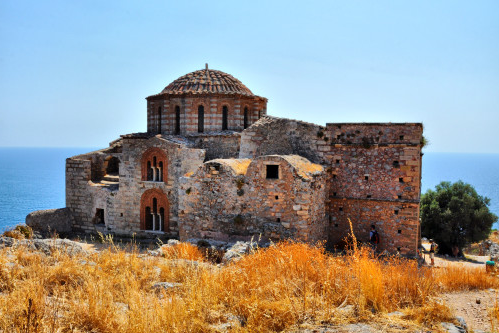The Gibraltar of the East
The Eastern Roman Fortress of Monemvasia held out against the Turks even after the fall of Constantinople in 1453.
Monemvasia is a town and a municipality in Laconia, Greece. The town is located on a small island off the east coast of the Peloponnese. The island is linked to the mainland by a short causeway 200m in length. Its area consists mostly of a large plateau some 100 metres above sea level, up to 300 m wide and 1 km long, the site of a powerful medieval fortress. The town walls and many Byzantine churches remain from the medieval period. The seat of the municipality is the town Molaoi.
The town's name derives from two Greek words, mone and emvasia, meaning "single entrance". Its Italian form, Malvasia, gave its name to Malmsey wine. Monemvasia's nickname is the Gibraltar of the East or The Rock.
 |
| Emperor Maurice by Emilian Stankev from "Rulers of the Byzantine Empire". The Fortress of Monemvasia was founded during the Emperor's reign. |
The town and fortress were founded in 583 by inhabitants of the mainland seeking refuge from the Slavic and the Avaric invasion of Greece. A history of the invasion and occupation of the Peloponnese was recorded in the medieval Chronicle of Monemvasia.
From the 10th century AD, the town developed into an important trade and maritime centre. The fortress withstood the Arab and Norman invasions in 1147; farm fields that fed up to 30 men were tilled inside the fortress. William II of Villehardouin took it in 1248, on honourable terms, after three years of siege; in 1259 William was captured by the Greeks after the battle of Pelagonia and in 1262 it was retroceded to Michael VIII Palaiologos as part of William's ransom.
It remained part of the Byzantine Empire until 1460, becoming the seat of an imperial governor, a landing place for Byzantine operations against the Franks, the main port of shipment (if not always production) for Malmsey wine, and one of the most dangerous lairs of corsairs in the Levant.
The Emperors gave it valuable privileges, attracting Roger de Lluria who sacked the lower town in 1292. The town welcomed the Catalan Company on its way eastward in 1302. In 1397 the Despot of the Morea,Theodore I Palaiologos, deposed the local dynast of Monemvasia, who appealed to Sultan Bayezid I and was reinstated by Turkish troops. In 1419 the rock appears to have come into the possession of Venice, though it soon returned to the Despot.
About 1401, the historian George Sphrantzes was born in the town. After the fall of Constantinople in 1453 Monemvasia held out against the threats of Sultan Mehmed II in 1458 and 1460, when it became the only remaining domain of the Despot of the Morea, Thomas Palaiologos, claimant of the Imperial throne. He had no forces to defend it; he offered it to the Sultan, and finally sold it to the Pope.
By 1464 the inhabitants found the Pope's representative feeble and the Pope unable to protect them; they admitted a Venetian garrison. The town was fairly prosperous under Venetian rule until the peace of 1502-3, in which it lost its farm lands, source of its food supply and of Malmsey wine. The food had to come by sea or from Turkish-held lands, and the cultivation of wine languished under Turkish rule.
The rock was governed by the Venetians until the treaty of 1540, which cost the Republic Nauplia and Monemvasia, her last two possessions on mainland Greece. Those inhabitants who did not wish to live under Turkish rule were given lands elsewhere. The Ottomans then ruled the town until the brief Venetian recovery in 1690, then again from 1715 to 1821. It was known as "Menekşe" ("Violet" in Turkish) during Ottoman rule and was a sanjak (province) centre in the Morea Eyalet.
The rock was governed by the Venetians until the treaty of 1540, which cost the Republic Nauplia and Monemvasia, her last two possessions on mainland Greece. Those inhabitants who did not wish to live under Turkish rule were given lands elsewhere. The Ottomans then ruled the town until the brief Venetian recovery in 1690, then again from 1715 to 1821. It was known as "Menekşe" ("Violet" in Turkish) during Ottoman rule and was a sanjak (province) centre in the Morea Eyalet.
The commercial importance of the town continued until the Orlov Revolt (1770) in the Russo-Turkish War, which saw its importance decline severely.
The town was liberated from Ottoman rule on July 23, 1821 by Tzannetakis Grigorakis who entered the town with his private army during the Greek War of Independence.
The "Gibraltar of the East"
Often referred to as the "Gibraltar of Greece," Monemvasia is a virtual showcase of Byzantine, Turkish, and Venetian history dating back to the 13th century. Worth climbing: the steep zigzag path that leads up and up, out of the lower town, to ruins of the fortified upper town, and sweeping views of the Mediterranean Sea.
 |
| Thomas Palaiologos Palaiologos was the last Byzantine ruler of the Fortress of Monemvasia. . After the conquest of Morea, Thomas lived in Rome, recognized throughout Christian Europe as the rightful Emperor of the East. To create greater support for his situation Thomas changed his religion to Roman Catholicism during his last years of life. After his death in 1465, the position of rightful Byzantine emperor was inherited by his older son Andreas Palaiologos, born in Mistra around 1453. (More) |
 |
| Church of Agia Sophia on top of the plateau |
(monemvasia.com) (Monemvasia)




